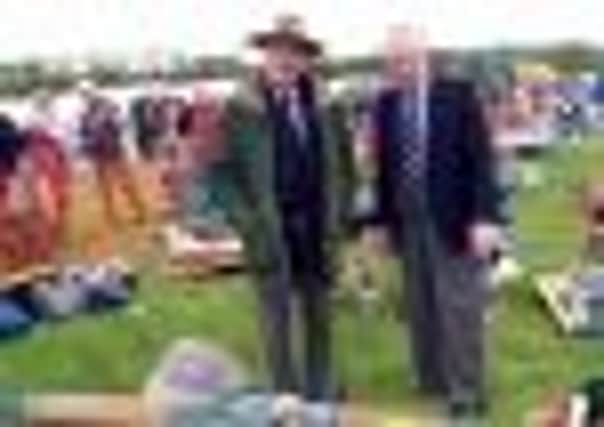Obituary: Flight-Lieutenant Sir Alan Smith CBE DFC DL


FLIGHT-LIEUTENANT Alan Smith was a war hero Spitfire flying ace in his own right, with five confirmed enemy “kills”. But he became best known as the wingman of legendary Second World War double leg amputee pilot Douglas Bader, flying close behind Bader to protect him from enemy fire. By pure chance – because of a bout of influenza – he was not behind Bader when the latter was forced to bale out of his Spitfire after a dogfight over France on 9 August, 1941, spending the rest of the war as a Nazi prisoner of war. Smith survived the war unscathed, married his Scottish sweetheart, settled in Kinross and became a highly successful businessman, mostly in the textile trade with his company Dawson International. The company won six Queen’s Awards for industry but was forced into administration last year, faced with a £117 million pension deficit.
Smith was knighted by the Queen at Buckingham Palace on 7 December, 1982 for his contributions to UK industry. He also served as a board member of the Scottish Development Agency in the 1980s and as chairman of Edinburgh-based investment bank Quayle Munro, which advises public and private companies, entrepreneurs and private equity investors, from 1988-93.
Advertisement
Hide AdAdvertisement
Hide AdAlan Smith was born in South Shields, at the mouth of the Tyne, on 14 March, 1917, while the Great War was still raging. He went to school in Sunderland but left at 14 to help his mother Lilian in her ironmonger’s after his father, a naval captain, was lost at sea. He was showing considerable entrepreneurial skills during the 1930s, including selling cigarettes, until war loomed and he enlisted in the RAFVR (Voluntary Reserve), learning to fly in de Havilland DH 82 Tiger Moth biplanes.
He converted to Spitfires during the Battle of Britain and was posted to RAF 616 Squadron in December 1940.
Transferred early the following year to RAF Tangmere near Chichester, West Sussex, his squadron and two others found themselves under Bader’s command in what became known as the Tangmere Wing. They nicknamed it the BBC – Bader’s Bus Company.
Bader, who had lost his legs while doing bravado aerobatics on a small plane in 1931, personally chose Smith as his Number Two, or wingman, to defend him on combat missions.
“God help you if you let any Hun get on my tail,” the man with the artificial legs barked at him. Bader and Smith usually flew on four-Spitfire missions, usually backed by Hugh “Cocky” Dundas and Johnnie Johnson, the latter to become the Western Allies’ highest-scoring fighter ace of the war.
Sir Alan remained a staunch supporter of Bader, who died in 1982, not least last year when a documentary film criticised Bader for risking his comrades’ lives by being too gung-ho, especially during the Big Wing operations against enemy aircraft over the Channel and Northern Europe, involving up to 60 RAF fighter planes.
The Big Wing strategy was controversial but Bader was all for it. Sir Alan later agreed. “It was very logical and very sensible, “ he said.
“Bader was a marvellous leader, a brilliant pilot, a dead shot and everything you relished. He didn’t just save my life, he saved a hell of a lot of lives.”
Advertisement
Hide AdAdvertisement
Hide AdWith Bader captured in 1941, Smith was posted to RAF Balado Bridge, near Kinross, now better-known to a younger generation as the venue for the annual T in the Park music festival, where he trained would-be RAF pilots.
It was there that he met Margaret Todd, a local girl who was aiding the war effort in the Women’s Voluntary Service. He was awarded the Distinguished Flying Cross in 1941, with the bar added in 1942.
From Scotland, he was sent back to combat operations in North Africa followed by further spells as an instructor, including in the US. He was allowed to return to Scotland to marry Margaret in July, 1943, and vowed to settle around Kinross once the war was over.
He would spend the rest of his life there, latterly at Ardgairney House in the village of Kirkton of Cleish, near Kinross.
By the end of the war, he had been awarded the Distinguished Flying Cross, with the bar added, and had recorded five confirmed “kills”, making him officially an RAF fighter ace.
After the war, he worked at a local wool mill run by Margaret’s father Herbert Todd of Todd and Duncan Ltd. He would eventually become manager and presided over the mill’s growth to become Dawson International Ltd. In the year ending March 2012, Dawson had a turnover of £9.7 million, with profits of £1.1m, employing 180 people and exporting 90 per cent of its knitwear. But the massive pension deficit led to administration last year.
He also served as chairman of the Perth-based Tay Foundation, a charitable trust which seeks to help the River Tay, its tributaries, fish and environment.
The Foundation aims to conserve and enhance the area’s fish species and their ecological cycles. He also served as a Deputy-Lieutenant for Perth and Kinross.
Advertisement
Hide AdAdvertisement
Hide AdSir Alan, his first wife Margaret and his second wife Lady Alice (née Moncur) were long involved with their local community. He was a former director of the Scottish Cashmere Association. He also served as chairman of the Perth-based Tay Foundation, a charitable trust which seeks to help the River Tay, its tributaries, fish and environment. The Foundation aims to conserve and enhance the area’s fish species and their ecological cycles.
In October 2009, Sir Alan and Lady Alice opened the new, state-of-the-art Loch Leven Health Centre in Kinross, designed by Ken Reid Architects of Edinburgh.
Sir Alan’s first wife Margaret died in 1971. He is survived by their three sons and a daughter, and by Lady Alice. Another daughter from the first marriage predeceased him. He died in Perth Royal Infirmary.